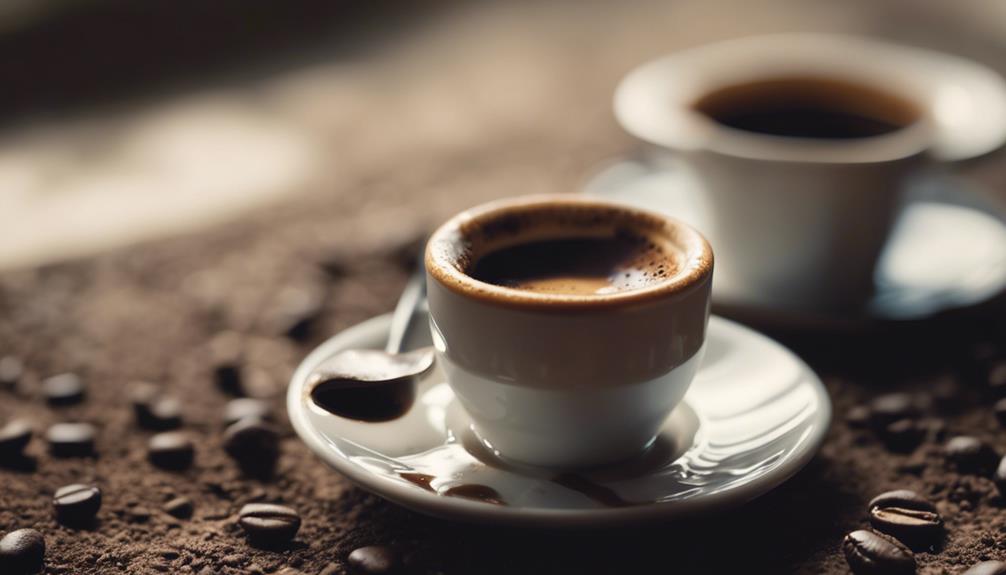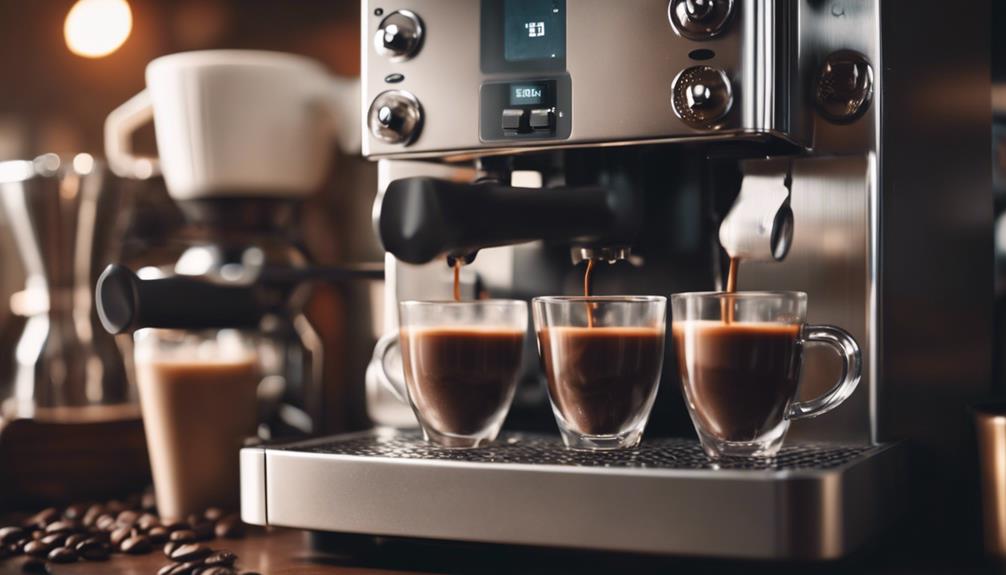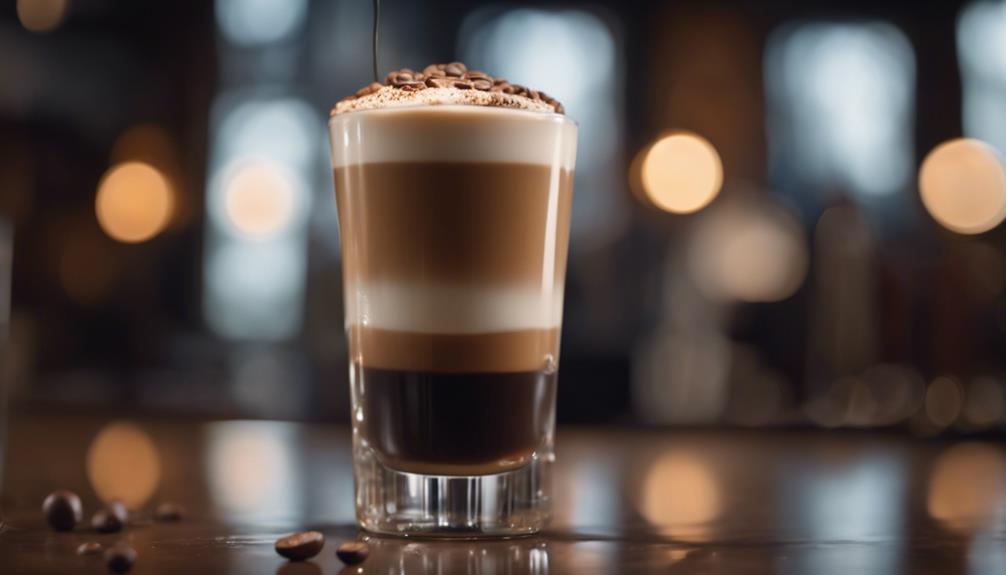Espresso has a stronger flavor compared to Turkish coffee. The high-pressure brewing process in espresso results in a bold and intense taste. On the other hand, Turkish coffee offers a smoother flavor as it intentionally leaves grounds in the cup. Espresso is made with a dark roast, while Turkish coffee is usually made with a medium roast. The grind size for Turkish coffee is finer than that of espresso. A shot of espresso contains around 63 milligrams of caffeine, slightly more than Turkish coffee. For more information on the distinctions between these two rich coffee experiences, continue reading the provided details.
Key Takeaways
- Espresso has a higher caffeine content than Turkish coffee.
- Espresso is known for its intense and bold flavor.
- Turkish coffee offers a smoother taste compared to espresso.
- Espresso is brewed under high pressure, enhancing its strength.
- Turkish coffee is renowned for its rich aroma and bold flavor.
Espresso Preparation Method
To prepare espresso, hot water is forced through finely-ground coffee at high pressure, resulting in a concentrated and intense flavor. Espresso machines are specially designed to execute this brewing process efficiently.
The high pressure at which the water is pushed through the coffee grounds is what distinguishes espresso from other brewing methods like Turkish coffee. This quick brewing method allows for the extraction of a rich and bold flavor profile that's beloved by many coffee enthusiasts.
The concentrated flavor of espresso is a direct result of the intense pressure applied during brewing. Unlike Turkish coffee, which involves a slower brewing process, espresso is known for its rapid extraction of flavors.
The fine grind of the coffee beans used in espresso preparation is essential to guarantee optimal extraction under the high pressure conditions. This unique preparation method not only sets espresso apart when it comes to taste but also contributes to its reputation for being stronger than Turkish coffee.
Turkish Coffee Brewing Technique
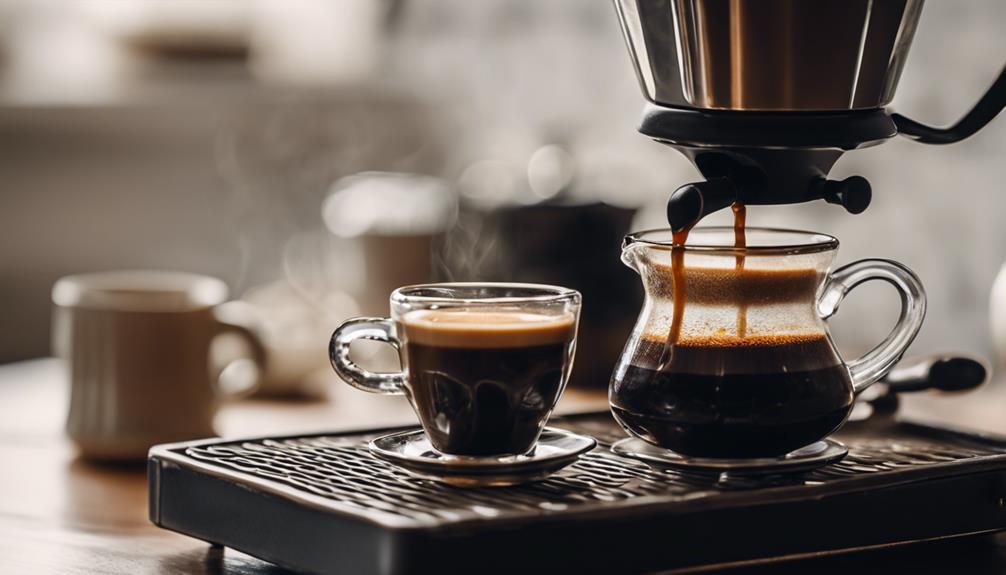
Brewing Turkish coffee involves combining finely ground coffee beans, water, and sugar in a cezve pot.
The mixture is slowly heated until it froths, producing a rich and flavorful coffee with a unique texture.
This traditional brewing process typically takes around 5-10 minutes to complete.
Brewing Turkish Coffee
When preparing Turkish coffee, combine finely ground coffee, cold water, and sugar in a cezve pot. This traditional method of brewing Turkish coffee requires patience and attention to detail to achieve its rich and bold flavor.
As you slowly heat the mixture in the cezve pot, make sure to stir it continuously. The grounds are intentionally left in the cup after brewing, adding to the unique taste and texture of Turkish coffee.
It typically takes around 5-10 minutes to brew Turkish coffee to the desired strength and consistency. The emphasis on the traditional brewing method highlights the importance of taking the time to savor each step for a truly satisfying coffee experience.
Traditional Coffee Preparation
When preparing Turkish coffee, the traditional brewing technique involves combining finely ground coffee, cold water, and sugar in a cezve pot. This method has been passed down through generations and is an important part of the cultural heritage of many regions.
The fine grind of the coffee beans is essential for achieving the strong flavor that Turkish coffee is renowned for. As the mixture is heated in the cezve pot, it slowly brews to perfection, developing a thick foam on top that adds to its unique character. The intense flavors of Turkish coffee are a result of this meticulous brewing process.
Once the coffee has foamed, it's essential to allow it to cool slightly before serving in a traditional Turkish coffee cup. This slow and deliberate preparation enhances the robustness of the flavor profile, making each cup a rich and aromatic experience that coffee enthusiasts appreciate.
Coffee Bean Roast Levels
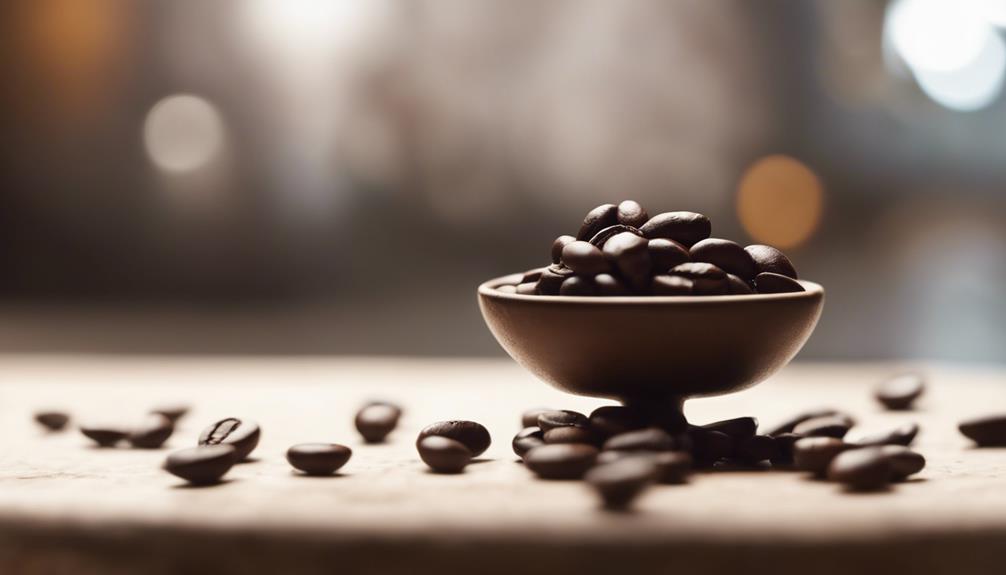
When evaluating coffee bean roast levels, it's imperative to understand the impact on flavor profiles and intensity.
The roasting process plays a significant role in determining the strength and aroma of your coffee. Different roasting techniques cater to the unique characteristics of Espresso and Turkish coffee, influencing their final taste experience.
Roast Intensity Levels
Roast intensity levels greatly influence the flavor profiles of both Espresso and Turkish coffee. Espresso requires a dark roast to bring out its intense taste fully. On the contrary, Turkish coffee needs a medium roast as it's brewed with hot water, necessitating a different approach to roasting.
The roasting intensity directly impacts the taste and aroma of the coffee, with darker roasts offering a bolder flavor profile compared to medium roasts. Specific roasting techniques are tailored for each type of coffee to enhance their distinct characteristics.
The choice of roast level for Espresso and Turkish coffee plays an essential role in determining the final taste and strength of the brew. Understanding the differences between dark roast for Espresso and medium roast for Turkish coffee is vital in crafting the perfect cup of either variety.
Flavor Profile Differences
The distinct flavor profiles of Espresso and Turkish coffee are directly influenced by the roast levels of the coffee beans used. Espresso, known for its intense and concentrated flavors, typically requires a dark roast to extract its full taste profile. On the other hand, Turkish coffee, with its rich and robust taste, is best brewed with medium-roasted beans to complement its brewing method. The roasting level plays a significant role in determining the strength and intensity of the coffee, with Espresso aiming for a bolder flavor compared to Turkish coffee.
| Espresso | Turkish Coffee |
|---|---|
| Dark roast | Medium roast |
| Intense flavor | Rich and aromatic |
| Concentrated flavors | Robust taste |
Grind Size Variation
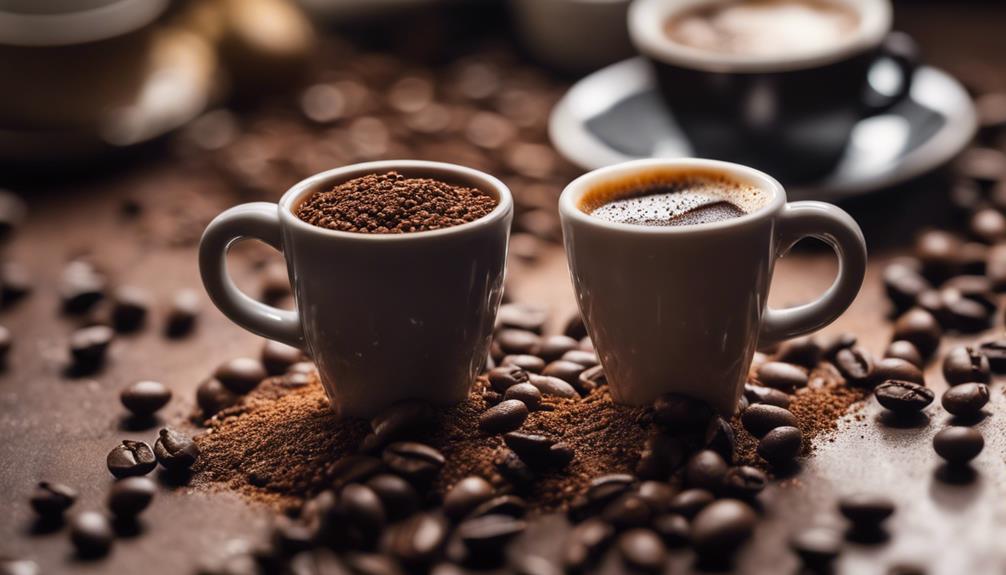
Adjusting the grind size is an essential step in optimizing the flavor extraction for both Turkish coffee and Espresso. When it comes to these two brewing methods, the grind size variation has a substantial impact on the taste and strength of your brew. Here's how grind size plays a pivotal role in enhancing your coffee experience:
- Turkish Coffee: To achieve the perfect cup of Turkish coffee, you need an extremely fine grind, almost resembling powdered sugar. This powder-like consistency allows for thorough extraction of flavors, resulting in a rich and intense brew.
- Espresso: Similarly, Espresso also requires a fine grind, although slightly coarser than Turkish coffee. This finer grind size helps resist over-extraction while still extracting enough flavor to produce the strong, bold shot of Espresso that many coffee lovers enjoy.
- Consistency Matters: In both Turkish coffee and Espresso brewing, maintaining a consistent and appropriate grind size is vital for ensuring the desired taste profile. Even a small variation in grind size can have a significant impact on the final flavor of your coffee.
Intensity of Flavor Profiles
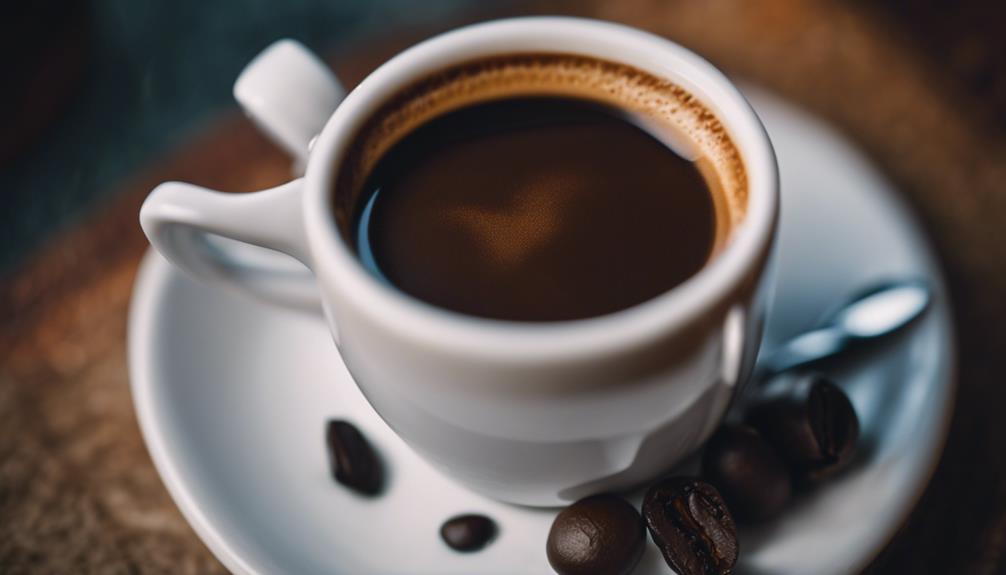
For a truly robust coffee experience, understanding the intensity of flavor profiles between Espresso and Turkish coffee is essential.
Espresso is renowned for its strong and bold taste, achieved through a high-pressure brewing process that extracts a robust flavor from fine coffee grounds. The intense flavor profile of Espresso sets it apart from Turkish coffee, which offers a smoother taste in comparison.
The high-pressure extraction method utilized in brewing Espresso contributes greatly to its bold and distinct flavor, making it a preferred choice for those craving a powerful coffee experience. Turkish coffee, while rich and flavorful, tends to provide a more mellow taste profile when contrasted with the concentrated richness of Espresso.
This difference in flavor intensity between Espresso and Turkish coffee highlights the diverse preferences that coffee enthusiasts may have when seeking out a specific taste profile in their daily brew.
Caffeine Content Variation
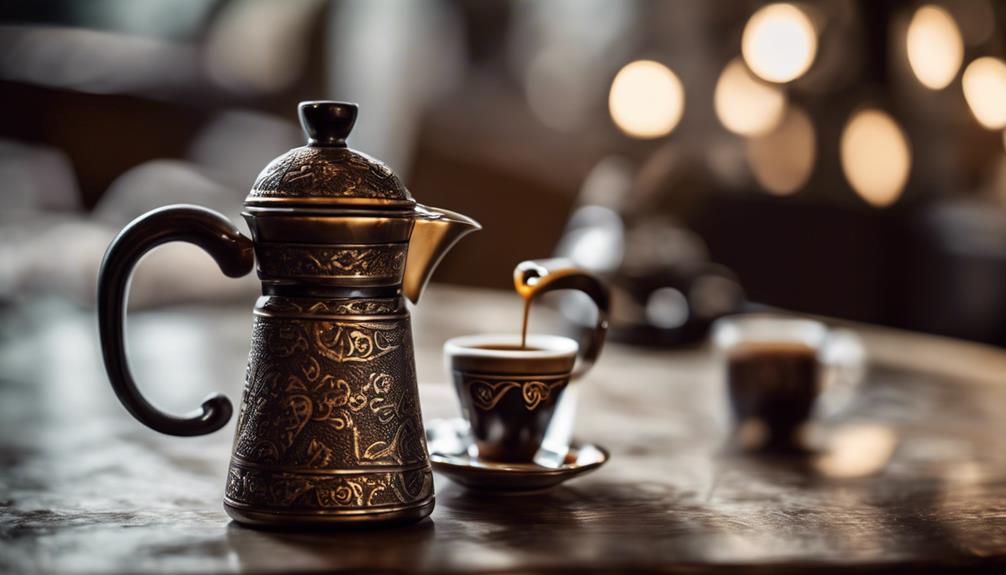
Understanding the caffeine disparities between Espresso and Turkish coffee is essential in appreciating their contrasting strengths. When it comes to caffeine content, Espresso typically contains around 63 milligrams per shot, while Turkish coffee ranges from 50 to 65 milligrams per serving.
Here are some key points to take into account:
- Brewing Method: Espresso requires a high-pressure extraction process, resulting in a more concentrated caffeine content per shot compared to Turkish coffee.
- Variability: The caffeine content in Turkish coffee can vary based on factors such as grind size, brewing time, and water temperature, leading to fluctuations in its overall strength.
- Overall Strength: Even though Turkish coffee boasts a bold flavor profile, a shot of Espresso generally packs a stronger caffeine punch per serving due to its intense brewing method.
Considering these aspects can help you choose the coffee that best fits your caffeine needs and preferences.
Preference for Strength & Taste
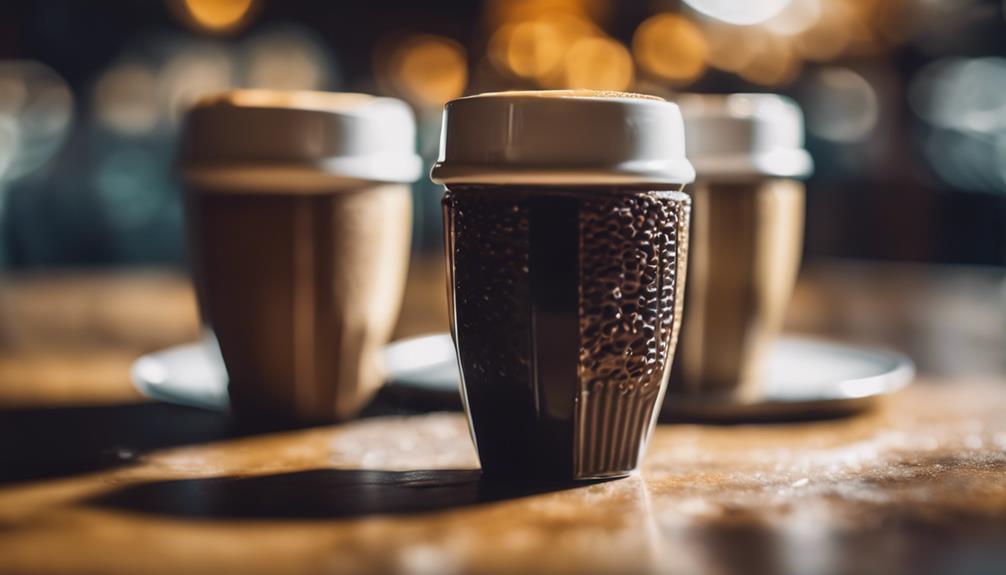
When choosing between Espresso and Turkish coffee, your preference for strength and taste plays a significant role in determining which brew suits your palate best. Espresso is known for its concentrated flavor and higher caffeine content per shot, offering an intense and robust coffee experience.
On the other hand, Turkish coffee provides a bold taste with a rich aroma, appealing to those who enjoy a different kind of intensity in their coffee. The brewing method also differs between the two, with Espresso being prepared under high pressure for quick extraction, contributing to its perceived strength compared to Turkish coffee.
Individual preferences for intensity and flavor profiles vary, leading to a divide in the choice between Espresso and Turkish coffee. Whether you lean towards the concentrated kick of Espresso or the bold richness of Turkish coffee, your taste buds hold the key to which brew will satisfy your coffee cravings.
Comparing Robust Coffee Experiences

Comparing robust coffee experiences between Espresso and Turkish coffee reveals distinct differences in caffeine content, flavor profiles, and brewing methods.
- Caffeine Content: Espresso packs a punch with approximately 63 milligrams per shot, slightly higher than the 50-65 milligrams found in a serving of Turkish coffee.
- Flavor Profiles: Turkish coffee boasts a bold flavor with a rich aroma, while Espresso is renowned for its concentrated and intense taste.
- Brewing Methods: Espresso is brewed rapidly under high pressure, resulting in a stronger coffee experience compared to the slower brewing process of Turkish coffee. This difference in brewing techniques contributes to the varying levels of strength between these two robust coffee options.
When it comes to choosing between Espresso and Turkish coffee for a truly intense coffee experience, understanding their caffeine content, flavor nuances, and brewing methods can help you select the brew that best suits your robust coffee preferences.
Frequently Asked Questions
Which Coffee Is Stronger Than Espresso?
Espresso is stronger than Turkish coffee due to its higher caffeine content per shot, with approximately 63 milligrams compared to Turkish coffee's 50-65 milligrams per serving.
The quick brewing process of Espresso, involving high-pressure hot water passing through finely-ground beans, creates a concentrated and intense flavor profile.
While Turkish coffee is robust and flavorful, its slower brewing method results in lower caffeine levels per serving, making Espresso the stronger choice for a quick and intense coffee experience.
Is Turkish Coffee Strong Coffee?
Yes, Turkish coffee is indeed considered a strong coffee option due to its intense flavor and concentrated brewing process.
With a rich aroma and robust taste, Turkish coffee typically contains 50-65 milligrams of caffeine per serving.
Its unique brewing method contributes to its reputation as a bold and flavorful choice for coffee enthusiasts looking for a potent caffeine kick.
What Is the Difference Between Turkish Coffee Cup and Espresso Cup?
When comparing Turkish coffee cups to espresso cups, the main difference lies in their size. A Turkish coffee cup typically holds 2-3 ounces, while an espresso cup holds 1-2 ounces.
Despite this disparity, the perceived serving sizes may appear similar due to the unique shapes and designs of each cup. Turkish coffee cups often feature intricate patterns, enhancing the cultural experience, while espresso cups are designed to maintain the crema on top, leading to a smaller size.
Is Espresso Stronger Than Arabic Coffee?
Yes, Espresso is generally stronger than Arabic coffee due to its concentrated brewing method and higher caffeine content.
Espresso's quick extraction process and high-pressure hot water passing through finely-ground coffee beans result in a potent and intense coffee shot.
Arabic coffee, including Turkish coffee, is brewed slowly and has a rich flavor but may have a lower caffeine content compared to Espresso.
Conclusion
When comparing espresso and Turkish coffee, it's clear that espresso takes the lead when it comes to strength. With its intense flavor profile, higher caffeine content, and robust brewing method, espresso offers a bold and invigorating coffee experience.
But don't count out Turkish coffee just yet – its unique brewing technique and rich taste provide a different kind of coffee enjoyment.
In the end, it all comes down to personal preference and the type of coffee experience you're seeking.
